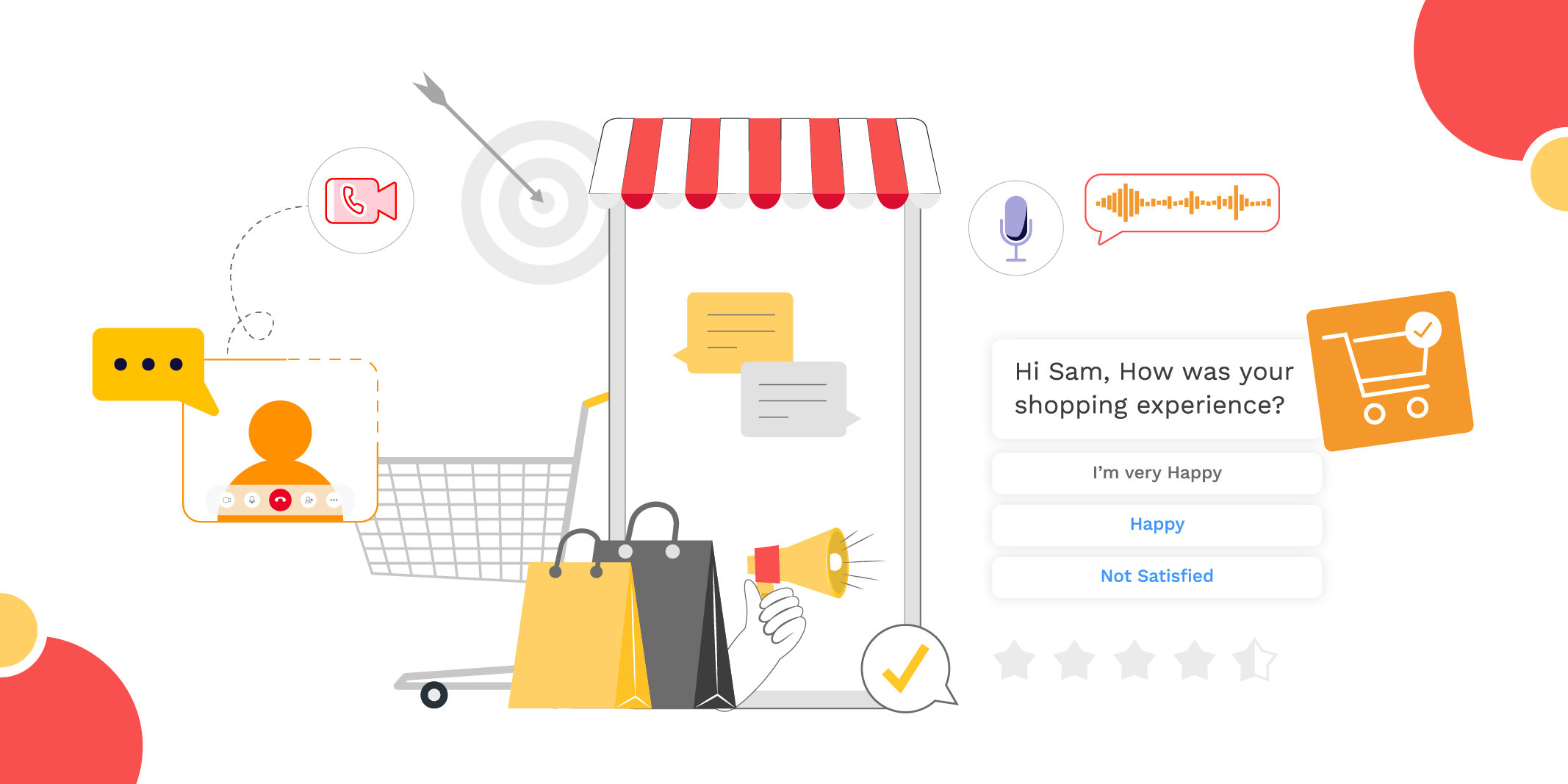
With shifting customer expectations, modern businesses are embracing conversation tools to enhance the customer experience across the buying journey. As a result, Conversational commerce has seen remarkable growth in adoption rate, with businesses worldwide leveraging the innovative approach for customer engagement.
Customer experience is a competitive differentiator and has emerged as a defining factor for business success. 88 % of people say that CX is as important as a business’s product/service, according to Salesforce. Conversational messaging tools enable companies to have meaningful customer interactions that drive engagement and boost revenues.
What is Conversational Commerce?
Conversational commerce refers to using conversation tools such as chatbots, messaging apps, Live Chat, voice assistants, and AI to support and improve the shopping experience. A conversational approach involves dialog and real-time communication.
By facilitating two-way communication, businesses can better understand customers’ needs, pain points, shopping patterns, and preferences, leading to meaningful engagement. Thus, offering a conversational customer experience provides an efficient way for businesses to attract and nurture prospects, convert them into customers, and provide support every step of the way.
Types of Conversational Tools
Chatbots
Chatbots are programs that use Natural Language Processing (NLP) and Artificial Intelligence (AI) for customer conversations. For example, you can use rule-based chatbots that rely on keywords and other language identifiers to trigger pre-set responses. AI-based chatbots, on the other hand, can identify the intent of a query and mimic human conversations.
The primary benefits of chatbots are automation, increased engagement, and scalability. Several businesses use chatbots to meet growing customer expectations for round-the-clock availability. Since bots can reply promptly to simple FAQs independent of human operators, it reduces agent workload.
Smart AI bot solutions are brilliant in simulating human interactions, thus boosting engagement. In addition to pre-determined responses, they can route complex queries to live agents, ensuring efficient query resolution.
Chatbots can operate on websites and help users navigate the pages more efficiently. You can also implement them on messaging apps and have simultaneous conversations with multiple customers.
Messaging apps
The ubiquity of messaging apps such as WhatsApp means they are excellent channels to reach customers. In addition, the rich features of messaging platforms enable businesses to have real-time customer conversations at scale.
You can share images, PDFs, videos, links, and maps with your customers on messaging apps, allowing an easy exchange of information. For example, you can share a PDF of your offerings so that customers can evaluate and make an informed decision. Similarly, you can send a How-to video while onboarding a new customer. In addition, customers who need post-purchase support can share screenshots of their issues and get a quick resolution. Moreover, businesses can request and receive customer feedback quickly on messaging apps.
In addition to supporting customers in making a purchase, you can also engage the customers with memes and emojis. Moreover, you can automate replies and provide round-the-clock support, providing a memorable conversational customer experience.
By embedding messaging widget on the website or placing a QR code on brochures and banners, you can get customers to interact with you on WhatsApp. Moreover, through integration with other business systems, such as CRM, leads can be directed to the right person for better conversions.
Voice Commerce
Voice commerce refers to conversational commerce, where customers can convey what they want with their voice. With the rising popularity of virtual assistants and smart speakers such as Apple Siri, Google Home, and Amazon Alexa, many customers prefer voice commands to type on an app, laptop, or phone.
Voice assistants can help customers make purchases, reorder items, and get answers to simple queries such as business hours and locations. When voice assistants connect to shopping platforms, it provides an easy way for customers to perform a range of tasks, including the following –
- Research products
- Add items to the wishlist
- Track an order
- Place an order
- Provide feedback or reviews
- Contact support
- Reorder items
Live Chat
Live chat is a potent tool for customer communication that can engage your website visitors and answer their queries promptly. With Live chat, a Live agent answers customer queries, adding a human touch to conversations. Moreover, unlike phone calls, the wait times are lesser, leading to improved customer satisfaction.
With Live chat, you can ensure that your website visitor has an exceptional brand experience, leading to conversion. In addition, you can proactively engage the visitors, answer questions, offer product recommendations, and provide quick support to complete a purchase.
Many users leave a website or an app without understanding the product features or figuring out how to make a payment. A company will likely lose valuable business if the website visitors do not get immediate support and accurate replies to queries. However, assigning a Live agent for each customer can be expensive. Live chat allows agents to have multiple conversations simultaneously, allowing businesses to engage customers at scale.
Live and Social shopping platforms
Livestream shopping, or Live shopping, is one of the hottest trends modern businesses use to sell products. It involves influencers and celebrities promoting products on social media and Live streaming platforms.
Livestream shopping happens on Instagram, Facebook, TikTok, and e-commerce platforms such as Alibaba. Live hosts interact with the audience and encourage purchases through special offers such as giveaways or limited-time offers. Since most offers are time-sensitive, it creates a sense of scarcity and urgency, leading to more purchases.
Getting Started with a Conversational Commerce Platform
1. Identify Business Objectives
Conversational tools can play a pivotal role in several business processes. Therefore, the first step in getting started with a conversational platform is to discuss with all your teams to identify core objectives.
Are you looking to streamline sales? Is high cart abandonment the problem you’re trying to solve? Do you need better customer service to achieve your full potential in the market?
Sometimes, you may have multiple goals you want to achieve through a conversational platform. You can set realistic goals by prioritizing your business needs and identifying roadblocks. For example, if you have a complex product, your customer support may need to educate customers and address queries in real-time to increase product adoption. On the other hand, if your path to purchase is complicated, you may need to work on reducing friction in the customer journey.
2. Choose the Right Conversational Platform Partner
The good thing about most conversational tools is that you need not build them from scratch. Instead, you can work with a competent technology partner to help you incorporate conversational channels into your marketing strategy quickly.
Looking at what your competitors are up to will give you a fair idea of how you can take advantage of conversational commerce. There are several conversational platforms available, each having its pros and cons. Analyzing customer feedback can give you strategic insights into the right solution for your business.
Other factors to consider are your existing business systems and how well they can operate in sync with the conversational solution. Go for conversational tools that integrate with platforms like CRM, Marketing Marketing Automation solutions, and payment gateways.
A crucial element of conversational platform implementation is assessing your teams’ expertise in solution management. For example, if you implement chatbots, your teams must understand how the leads will be routed to different departments and where to track conversations.
Working with a reliable conversational platform partner like Kaleyra will simplify the implementation process. Through guidance and support, Kaleyra will help you identify the best channels and ensure you get the most out of the platform.
3. Design a Conversational Strategy
Once you have identified a conversation platform partner, it’s time to define the conversational customer experience workflow and how to embed it into your marketing, customer service, and sales processes. Collect common queries that the customer support team spends their time on. What sales tasks can you automate through the platform? How can you improve engagement?
For example, If you chose WhatsApp business API as your conversational solution, you can automate Welcome messages, run Abandoned cart recovery campaigns, reengagement campaigns, and schedule order tracking messages.
List the channels your customers are active on and their pain points, and curate answers. Make sure to keep the language simple and conversational. If you have a list of services, you can display that as a menu to help customers choose their topic.
For example, if a customer wants to talk to a Live agent, you can ask them to specify a convenient time and a phone number for a callback. Think through the conversation while configuring automated replies, scheduling campaigns, and training chatbots. Make sure to test your solution before launch to identify potential issues and areas of improvement.
4. Monitor and Analyze Performance
Once you have launched the conversational platform, you must monitor it to ensure it meets your business needs. Identify key performance indicators (KPIs) and track them regularly. Some of the KPIs you can monitor include
- Conversion rates
- Query Resolution Time
- Cart abandonment rates
- Customer satisfaction scores
- Number of conversations
Tracking metrics will help you measure the success of your conversational commerce platform and make necessary tweaks for better Performance. Moreover, analytics will help you derive strategic insights to help you increase your customer engagement and business efficiency.

Kalaivani Narayanan
Content Specialist
Supercharge Your Communication!
Get in touch with our experts who strive hard to bring the very best in cloud communications technology to you.

